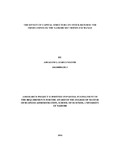| dc.description.abstract | The goal of the study was to investigate the effect of capital structure on stock returns
for firms listed on the Nairobi Securities Exchange. The period of focus was from 1st
January 2011 to 31st December 2015. The study adopted a causal research design and
multiple regression analysis was used to investigate this effect at 95% confidence
level. Other independent variables adopted in the study were profitability measured by
earnings per share, firm size measured by firms’ total assets and liquidity measured by
the average annual trading as a quotient of the outstanding shares in number.
Secondary data was utilized for both the dependent and independent variables. The
data was obtained from Nairobi Securities Exchange (NSE) historical data on price
changes and volume between 1st January 2011 and 31st December 2015 and the 2016
NSE handbook financial reviews per company. Regression analysis results disclosed
that overall, capital structure has a positive bearing on stock returns for firms listed on
the Nairobi Securities Exchange within the period the study was carried out. The
sectorial analysis also showed that capital structure has a positive effect on stock
returns in the different sectors except for the agricultural sector, investment and
telecommunication sectors. The results are however not statistically significant and
can therefore not be used to meaningfully explain changes in stock returns for firm’s
listed on the Nairobi Securities Exchange. Nevertheless, the results were found to be
statistically significant for the telecommunication sector even though only one firm
was reviewed in the sector. Overall, in addition to the positive effect of capital
structure on stock returns, profitability and stock liquidity had a positive impact while
firm size had a negative impact on a firm’s stock returns. None of the variables were
deduced to be statistically significant and the model adopted only accounted for 4.4%
variation in stock returns. Other factors not factored in the model employed in the
study thus account for 95.6% of the variation in stock returns. Correlation analysis
pointed at weak positive correlations between stock returns and all the independent
variables. The correlation was only found to be statistically significant between stock
returns and stock liquidity. The researcher recommends research on other variables
not employed in this study that could account for the 95.6% variation that has not
been accounted for by the model adopted. The period of the study can also be
extended in future research and different proxies for measuring different variables
employed in the same study to eliminate the weaknesses that associated with
particular proxies for the independent variables. | en_US |



